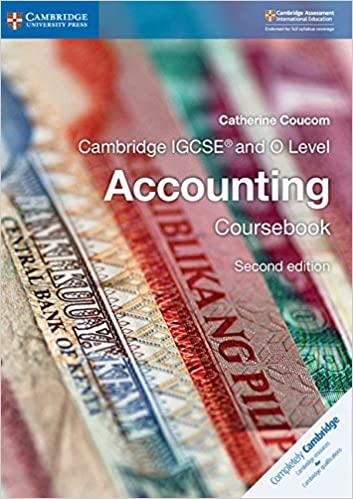Question
NOTE: Each Group will be provided with different project numbers. Business set up cost: Vending machines cost $6,000 each; Funding for the machine will come
NOTE: Each Group will be provided with different project numbers.
Business set up cost:
- Vending machines cost $6,000 each;
- Funding for the machine will come from 40% equity contribution by Andrew as a business owner. He will borrow (debt finance) the rest from a bank.
Borrowing a business loan to help finance the investment project:
St Thomas Bank has read Andrew's business plan and for the loan proposes the following terms and conditions:
- A 6 year loan with repayment instalments at the end of each year;
- Interest charged on the loan is fixed at an effective annual interest rate of 5%;
To repay the loan, Andrew anticipates that he will be able to use the cash flow generated from the snack vending machine business. According to the Business plan the stream of cash flow from the snack vending project is as follows:
- $16,000 at the end of year 1;
- $16,000 at the end of year 2;
- $16,000 at the end of year 3;
- $16,000 at the end of year 4;
- $16,000 at the end of year 5; and
- $16,000 at the end of year 6
Setting up a business as a small company with ordinary shares.
He would like to register the business and incorporate it as a privately owned company through share issue. The following is information relating to this:
- The business will have outstanding ordinary shares of 10,000 at $2.88 per share.
- The market Beta for a business investment of similar type is 1.1;
- The market risk free rate is 3%; and
- The expected market risk for similar investments is 8%.
Required: Andrew is enrolled in ACTG103 and realises that he has learnt valuation techniques that can help him work out whether his proposed Business Plan is a good plan. We are also curious to help Andrew identify the different valuation techniques and when to apply them to work out
Part 1: Loan Amortisation
(1) Calculate the size of annual instalment. (1 mark)
(2) Calculate the total repayments over the term of the loan. (1 mark)
(3) Calculate the total interest payable over the term of the loan. (1 mark)
(4) Create a loan repayment schedule for the loan amortization. (3 marks)
Based on the Loan Repayment Schedule, satisfy the following:
(5) Calculate the loan outstanding at the end of year 2. (1 mark)
(6) Calculate the loan outstanding at the end of year 3. (1 mark)
(7) Calculate the total principal repaid in year 3. (1 mark)
(8) Calculate the total interest paid in year 3. (1 mark)
(9) Create a loan repayment schedule for the fourth and fifth periods of the loan. (1 mark)
Step by Step Solution
There are 3 Steps involved in it
Step: 1

Get Instant Access to Expert-Tailored Solutions
See step-by-step solutions with expert insights and AI powered tools for academic success
Step: 2

Step: 3

Ace Your Homework with AI
Get the answers you need in no time with our AI-driven, step-by-step assistance
Get Started


